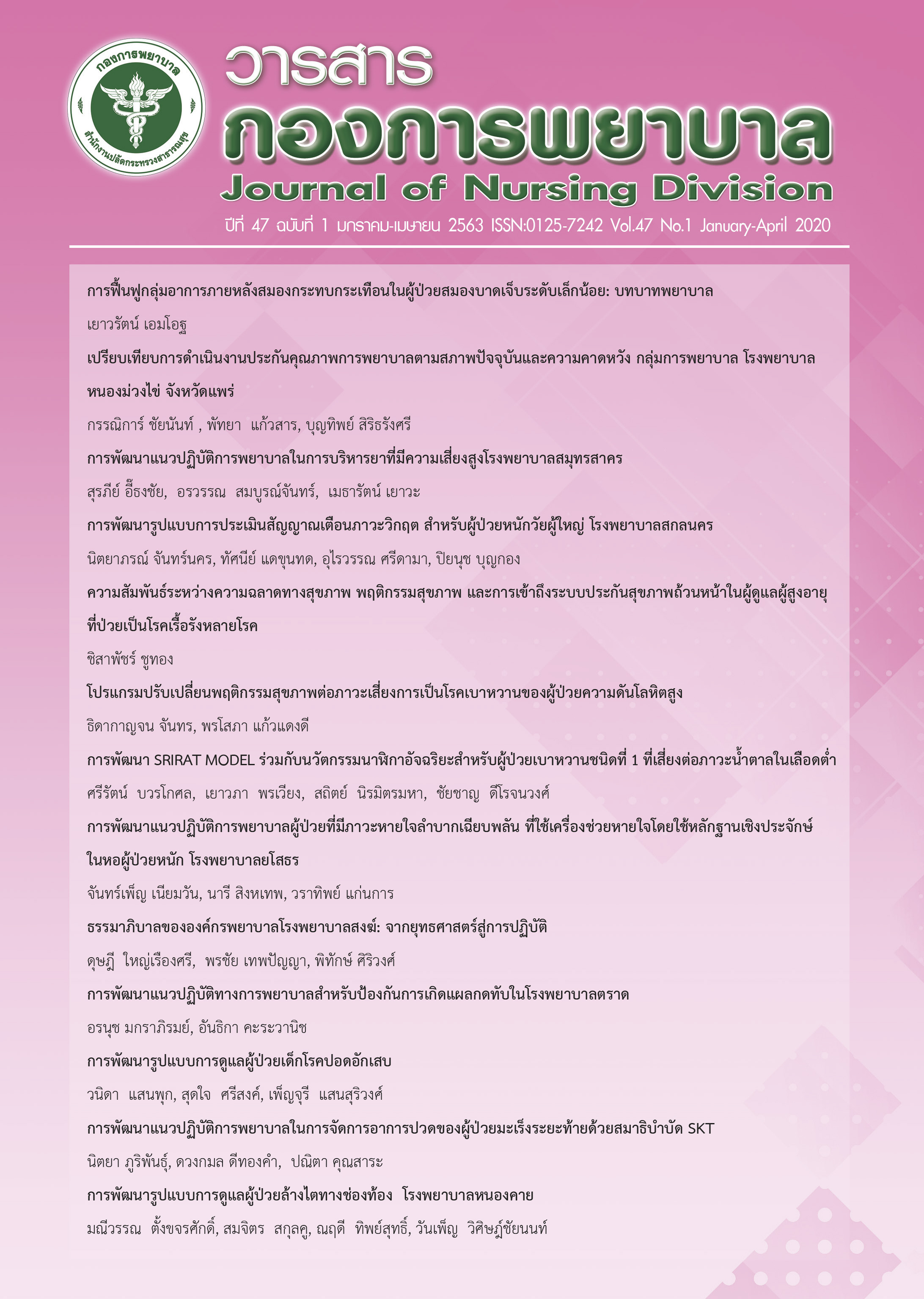การพัฒนาแนวปฏิบัติการพยาบาลผู้ป่วยที่มีภาวะหายใจลำบากเฉียบพลัน ที่ใช้เครื่องช่วยหายใจโดยใช้หลักฐานเชิงประจักษ์ในหอผู้ป่วยหนัก โรงพยาบาลยโสธร
Main Article Content
บทคัดย่อ
กลุ่มอาการหายใจลำบากเฉียบพลัน (ARDS) เป็นการบาดเจ็บที่ปอดมีความสัมพันธ์กับอัตราการตายสูง การใช้เครื่องช่วยหายใจเป็นการรักษาแบบประคับประคอง แต่เพิ่มความเสี่ยงที่จะทำให้เกิดภาวะแทรกซ้อนด้านร่างกายหลายประการ การศึกษาครั้งนี้มีวัตถุประสงค์เพื่อพัฒนาแนวปฏิบัติการพยาบาลผู้ป่วยที่มีภาวะหายใจลำบากเฉียบพลันที่ใช้เครื่องช่วยหายใจโดยใช้หลักฐานเชิงประจักษ์ในหอผู้ป่วยหนัก โรงพยาบาลยโสธร ดำเนินการศึกษา 4 ขั้นตอน ดังนี้ 1) Evidence-triggered phase เป็นการค้นหาปัญหาการพยาบาลผู้ป่วยที่มีภาวะหายใจลำบากเฉียบพลันที่ใช้เครื่องช่วยหายใจ 2) Evidence-support phase สืบค้น และคัดเลือกงานวิจัย 3) Evidence-observe phase เป็นการสร้างแนวปฏิบัติการพยาบาล 4) Evidence-based phase การนำแนวปฏิบัติไปใช้กับผู้ป่วยจำนวน 51 คน แบ่งเป็น 2 กลุ่ม 1) กลุ่มที่ไม่ได้ใช้แนวปฏิบัติ จำนวน 24 คน 2) กลุ่มที่ใช้แนวปฏิบัติ จำนวน 27 คน และพยาบาลวิชาชีพที่ดูแลผู้ป่วยจำนวน 25 คน ประเมินผลลัพธ์ทางคลินิก และความคิดเห็นของพยาบาลวิชาชีพ วิเคราะห์ข้อมูลด้วยสถิติเชิงพรรณนา เปรียบเทียบผลลัพธ์ทางคลินิกใช้สถิติ Independent t-test และสถิติ Relative risk
ผลการศึกษาพบว่า กลุ่มที่ไม่ได้ใช้แนวปฏิบัติ มีอายุเฉลี่ย 63.7 ปี APACHE II score มีค่าเฉลี่ย 17.83 ส่วนกลุ่มที่ใช้แนวปฏิบัติ มีอายุเฉลี่ย 64.2 ปี APACHE II score มีค่าเฉลี่ย 18.16 การนำแนวปฏิบัติการพยาบาลไปใช้ พบว่า กลุ่มที่ใช้แนวปฏิบัติ มีอุบัติการณ์การเกิดภาวะพร่องออกซิเจน การคั่งของคาร์บอนไดออกไซด์ อันตรายเนื่องจากแรงดันของอากาศ และ APACHE II score ลดลงกว่ากลุ่มที่ไม่ใช้แนวปฏิบัติ อย่างมีนัยสำคัญทางสถิติที่ระดับ .05 จำนวนวันนอนเฉลี่ยในหอผู้ป่วยหนักของกลุ่มที่ใช้แนวปฏิบัติต่ำกว่ากลุ่มที่ไม่ได้ใช้แนวปฏิบัติ นอกจากนี้พยาบาลวิชาชีพผู้ใช้แนวปฏิบัติ มีความเห็นว่าแนวปฏิบัติการพยาบาลผู้ป่วยที่มีภาวะหายใจลำบากเฉียบพลันที่ใช้เครื่องช่วยหายใจสามารถนำไปใช้ได้ในสถานการณ์จริง มีความคุ้มค่าในการเปลี่ยนแปลงสู่การปฏิบัติ และมีความพึงพอใจในระดับมาก
Article Details
เอกสารอ้างอิง
50 countries. JAMA. 2016;315(8):788-800.
2. Sensen B, Braune S, de Heer G, et al. Life after ARDS. Med Klin Intensivmed Notfmed. 2017;112(7):605-11.
3. Ranieri VM, Rubenfeld GD, Thompson BT, et al. Acute respiratory distress syndrome: the Berlin Definition. JAMA. 2012; 307:2526-33.
4. Walkey AJ, Summer R, Ho V, et al. Acute respiratory distress syndrome: epidemiology and management approaches. Clin Epidemiol. 2012; 4:159-69.
5. Slutsky AS, Ranieri VM. Ventilator-induced lung injury. N Engl J Med. 2013;369(22): 2126-36.
6. Pookboonmee R. Role of nurses in Thailand 4.0. [cited 2019 June 16]; Available from: https://med. mahidol.ac.th/ramachannel/home/article. Thai.
7. Chrisman J. Exploring evidence-based practice research. Nursing Made Incredibly Easy. 2014;12(4):8-12.
8. Kathleen R. The Impact of Evidence-Based Practice in Nursing and the Next Big Ideas. OJIN. 2013;18(2).
9. Medical Record. Nursing Organization, Yasothon Hospital; 2018.
10. Soukup M. The center for advanced nursing practice evidence-based practice model promoting the scholarship of practice. Nurs Clin North Am.
2000;35(2):301-9.
11. Melnyk BM, Fineout-Overholt E. Evidence base practice in nursing & healthcare: A guide to best practice. Philadelphia: Lippincott Williams & Wilkins; 2005.
12. Jordan Z, Lockwood C, Aromataris E, et al. The updated JBI model for evidence-based healthcare. The Joanna Briggs Institute; 2016.
13. Bein T, Weber-Carstens S, Goldmann A, et al. Lower tidal volume strategy (approximately 3 ml/kg) combined with extracorporeal CO2 removal versus
“conventional” protective ventilation (6 ml/kg) in severe ARDS: the prospective randomized xtravent- study. Intensive Care Med. 2013;39:847-56.
14. Kasenda B, Sauerbrei W, Royston P, et al. Multivariable fractional polynomial interaction to investigate continuous effect modifiers in a meta-analysis on
higher versus lower PEEP for patients with ARDS. BMJ.Open. 2016;6(9):e011148.
15. Hu SL, He HL, Pan C, et al. The effect of prone positioning on mortality in patients with acute respiratory distress syndrome: a meta-analysis of randomized
controlled trials. Crit Care. 2014;18:R109.
16. Munshi L, Del Sorbo L, Adhikari NKJ, et al. Prone positioning in severe acute respiratory distress syndrome. A Systematic Review and Meta-Analysis. Ann Am
Thorac Soc. 2017;14 (Suppl 4): S280-8.
17. Alhazzani W, Alshahrani M, Jaeschke R, et al. Neuromuscular blocking agents in acute respiratory distress syndrome: a systematic review and meta-analysis of
randomized controlled trials. Crit Care. 2013;17:R43.
18. Rice TW, Wheeler AP; National Heart, Lung, and Blood Institute Acute Respiratory Distress Syndrome (ARDS)Clinical Trials Network. Initial trophic vs full
enteral feeding in patients with acute lung injury: The EDEN Randomized Trial. JAMA. 2012;307(8):795-803.
19. Cavalcanti AB, Suzumura EA, et al. Effect of lung recruitment and titrated Positive End-Expiratory Pressure (PEEP) vs Low PEEP on mortality in patients with
acute respiratory distress syndrome: A randomized clinical trial. JAMA. 2017;318(14):1335–45.
20. Guervilly C, Bisbal M, Forel JM, et al. Effects of neuromuscular blockers on transpulmonary pressures in moderate to severe acute respiratory distress
syndrome. Intensive Care Med. 2017;43(3):408-18.
21. Keddissi JI, Youness HA, Jones KR, et al. Fluid management in acute respiratory distress syndrome: A narrative review. Can J Respir Ther. 2019;55:1–8.
22. Lakhal K, Ehrmann S, Benzekri-Lefevre D, et al. Respiratory pulse pressure variation fails to predict fluid responsiveness in ARDS. Crit Care. 2011;15(2):R85.
23. Casey JD, Semler MW, Rice TW. Fluid management in Acute Respiratory Distress Syndrome. Semin Respir Crit Care Med. 2019;40(1):57-65.
24. Fan E, Del Sorbo L, Goligher EC, et.al. An Official American Thoracic Society/European Society of Intensive Care Medicine/Society of Critical Care Medicine
Clinical Practice Guideline: Mechanical ventilation in adult patients with acute respiratory distress syndrome. Am J Respir Crit Care Med. 2017;195(9):1253-63.
25. Polit D, & Hungler B. Essential of nursing research: A text and work book Philadelphia: Lippincott; 1997. p. 261-280.
26. Appraisal of guidelines for research and evaluation II: AGREE II instrument [Internet]. 2018 [cited
2018 Feb 2]; Available from http://www.agreetrust.org/wp-content/uploads/2013/10/AGREE-II-Users-
Manual-and-23-item-Instrument_2009_ UPDATE_2013.pdf.
27. Cohen J. Statistical Power Analysis for Behavioral Sciences. New York: Academic Press. Stata Corp. 2003. STATA Reference Manual Release 10. Texas: Stata
Press; 1977.


